Hi Paul,Hi,
In my opinion the Dayton DS215PR and the Eminence Beta 8cx are not a good match for a passive radiator system. You cannot design a flat response with it. The moving mass Mmp of the Dayton seems to be 75g minimum. The Dayton is more intended to use together with speaker drivers with a low fs.
The Beta 8cx has a rather stiff suspension, its fs is 62Hz and Vas is 21.4 litres. Like mentioned earlier, you cannot make a system that goes low with the Beta 8cx.
For a passive radiator system with this driver you have to choose a enclosure volume of about 12 litres and choose a good matching passive radiator to give some boost in the 70-150Hz frequency region. The Seas SP22R is a good choice. I have done some simulations based on the R.Small passive radiator transfer functions with a self made calculation tool with Pspice and also with the Unibox407 calculation tool. Both calculations give the same results. You can realize a flat response with a -3dB point at about 80Hz. For the SP22R I have chosen Mmp=28g, Sdp=230cm2, Vap=138 litres. The resonance frequency fB is about 75Hz for this system. Unibox tells me that the passive radiator maximum excursion appears at 60W. I will check that in a Leap simulation soon. It will take me some time, because I have to make transducer models in Leap for that simulation.
When you can give me an idea of the enclosure sizes you have in mind, I can do the Leap simulation inclusive the enclosure response also.
Paul
Thank you for the effort in doing the simulation etc. Yes I am aware that the speaker will not be excellent in bass. But in this project I am messing around with high efficiency speakers. And they all seem to have this problem. It's the powerful motor resulting is huge back emf resulting in a really high impedance at Fs of nearly a 100 ohm.
I neglected to mention earlier that I am running this from an firstwatt to F2J amplifier clone. So that results in this huge boost in the bass around Fs. So instead of getting a cut at Fs in the cabinet, I actually now have a boost and it will happily go down to 80 Hz. I am running it BR now and that pushes it to about 60Hz. However I think the port frequency is too high and it is pushing into Fs. So that's a double effect resulting in too much gain. But I would like to try push it down to 30-40Hz if I can with a PR. If I understand it correctly, the PR typically has a narrower band.
But you are right about one thing, I should have gotten the SEAS. I could always tune it lower. The qms of 2 for the Dayton is really low. Resulting in poor gain.... I should go out and buy the SEAS...
Oon
One of the speakers I heard that I really like is the Audio Note... I realize after messing around with an 8 inch why their box is so big, to prevent pushing up the Fs..
AN woofers have soft suspensions hence low Fs and depending on Qts, the volume needed for box tuning would be relatively large. These are hifi speakers technology, not very similar to PA units.
I neglected to mention earlier that I am running this from an firstwatt to F2J amplifier clone. So that results in this huge boost in the bass around Fs. So instead of getting a cut at Fs in the cabinet, I actually now have a boost and it will happily go down to 80 Hz. I am running it BR now and that pushes it to about 60Hz. However I think the port frequency is too high and it is pushing into Fs. So that's a double effect resulting in too much gain. But I would like to try push it down to 30-40Hz if I can with a PR. If I understand it correctly, the PR typically has a narrower band.
But you are right about one thing, I should have gotten the SEAS. I could always tune it lower. The qms of 2 for the Dayton is really low. Resulting in poor gain.... I should go out and buy the SEAS...
Oon
Hi Oon,
Of course, using the Firstwatt as the amplifier makes it totally different. The amplifier output impedance is 15 Ohms, that is right? In this way the electrical damping becomes very poor. I have to look in the simulation what the consequences are. Can you give me the internal volume Vb of your actual speaker. And the basreflex port data, or the tuning frequency fB?
Maybe the Seas is also not a good option with that amplifier.
I will look at it, what might be the best solution using the Firstwatt.
Paul
A conjugate RCL filter then you seek, Oon.
Yes indeed, excellent tip !
Or using the network values to tune the response!
Paul
I used a 50 ohm resistor. So I should be getting a output impedance of about 50 ohms... I am also using a minidsp for the crossover using FIR...Hi Oon,
Of course, using the Firstwatt as the amplifier makes it totally different. The amplifier output impedance is 15 Ohms, that is right? In this way the electrical damping becomes very poor. I have to look in the simulation what the consequences are. Can you give me the internal volume Vb of your actual speaker. And the basreflex port data, or the tuning frequency fB?
Maybe the Seas is also not a good option with that amplifier.
I will look at it, what might be the best solution using the Firstwatt.
Paul
Thanks for all the effort. I am more of an experimantelist... Still learning my way through simulation...
Box volume is about 30 litres and Port length of about 4 inch and diameter of 2 inch..
Oon
Sent from my F8332 using Tapatalk
Last edited:
They are similar in terms of efficiency... There are not many hifi speakers with efficiency in the order of 95db /watt... They don't really exist there... Only in the pro speaker section... They have beautiful mids though...AN woofers have soft suspensions hence low Fs and depending on Qts, the volume needed for box tuning would be relatively large. These are hifi speakers technology, not very similar to PA units.
AN claims it to be the key to their sound... And many people who tried will tell you that high efficiency speakers and low efficiency speakers sound different...
Oon
High efficiency speakers tend to use light cones - more breakup and a more ragged response, lots of stored energy. I heard some Fostex in back loaded horns that made a lot of sound, but it was no better (but louder and much beamier) than what you get from mounting $5 nxt exciters to cardboard.
I used a 50 ohm resistor. So I should be getting a output impedance of about 50 ohms... I am also using a minidsp for the crossover using FIR...
Thanks for all the effort. I am more of an experimantelist... Still learning my way through simulation...
Box volume is about 30 litres and Port length of about 4 inch and diameter of 2 inch..
Oon
Sent from my F8332 using Tapatalk
Hi Oon,
For Zout = 50Ohms, only mechanical damping is applied in your system.
These are the frequency response and impedance of the Beta 8cx in a 30litre box and a port of 2 inch diameter and 4 inch length (fB = 37Hz) with walls covered with damping material; simulation in Leap on infinite baffle.
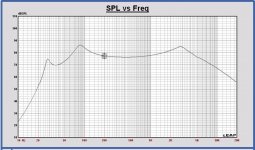
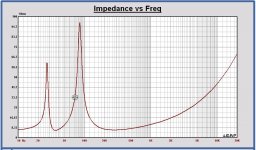
What you can do is adding a lot of damping material in the box to increase the mechanical damping of the system. But you have to apply heavy fill in that case.
I have done a simulation by adding damping material for a impedance peak reduction to about 22 Ohm (highest impedance peak).
These are the simulation results for the frequency response and impedance in Leap.
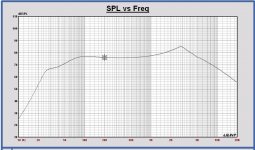
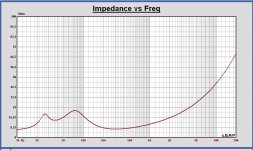
It is an unusual approach doing this way, but in my opinion it can work.
There is also the option adding a RLC in parallel, what Loyzek is mentioning.
Maybe a combination of more fill and such a RLC parallel circuit.
I will look at it later (for fun 🙂).
Paul
Sure, these AN units are produced with large magnets, low Fs and are capable of 90 dB/2,83V/1m radiating 4 pi but this doesn't have anything to do with sounding particularly good. It's just sensitivity.
I have the data on AN model E loudspeaker kit that uses an 8" Seas unit with following TS parameters.
Audio Note SPKR-002/06526:
Fs=29
Re=3,2
Qms02,1
Qes=0,27
Qts=0,24
Vas=120
SPL=92,5 dB/1W/1m
SPL=96,4 dB/2,83V/1m
I agree that one doesn't find often a driver of similar specs. Maybe a Seas CA 26 RE4X or one of the Acoustic Elegance might compete.
I have the data on AN model E loudspeaker kit that uses an 8" Seas unit with following TS parameters.
Audio Note SPKR-002/06526:
Fs=29
Re=3,2
Qms02,1
Qes=0,27
Qts=0,24
Vas=120
SPL=92,5 dB/1W/1m
SPL=96,4 dB/2,83V/1m
I agree that one doesn't find often a driver of similar specs. Maybe a Seas CA 26 RE4X or one of the Acoustic Elegance might compete.
Hi Oon,
I have done some Leap simulations using a RLC serial network placed parallel with the speaker.
For your current setup I use Vb = 30 litres, port length = 4inch and port diameter = 2inch (or fB = 37Hz) and walls covered with damping material.
And I add an RLC serial network, R = 8.2 Ohm, L = 5.6 mH and C = 680 uF. Zout amplifier = 50 ohm.
frequency response:
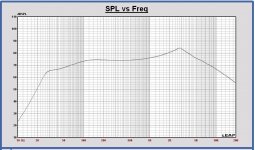
Increasing the tuning frequency fB to 50 Hz makes it even better.
As setup I choose Vb = 30 litres, port length = 5 inch and port diameter = 3inch (or fB = 50Hz) and walls covered with damping material. Zout amplifier = 50 ohm.
And I add an RLC serial network, R = 8.2 Ohm, L = 5.6 mH and C = 680 uF.
frequency response:
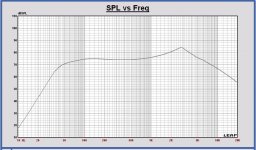
These are simulations. In practice the impedance value probably will be a little different due to tolerances and different losses in your system. But the Leap simulation shows that something can be solved with the RLC network.
Remark that the frequency response simulations are done again for an infinite speaker baffle. In this way you see the low frequency system behaviour.
For the crossover design you need the full space frequency responses. I can also simulate these, but in that case I need the outer cabinet dimensions.
With thanks to Lojzek for the RLC tip !
Paul
I have done some Leap simulations using a RLC serial network placed parallel with the speaker.
For your current setup I use Vb = 30 litres, port length = 4inch and port diameter = 2inch (or fB = 37Hz) and walls covered with damping material.
And I add an RLC serial network, R = 8.2 Ohm, L = 5.6 mH and C = 680 uF. Zout amplifier = 50 ohm.
frequency response:

Increasing the tuning frequency fB to 50 Hz makes it even better.
As setup I choose Vb = 30 litres, port length = 5 inch and port diameter = 3inch (or fB = 50Hz) and walls covered with damping material. Zout amplifier = 50 ohm.
And I add an RLC serial network, R = 8.2 Ohm, L = 5.6 mH and C = 680 uF.
frequency response:

These are simulations. In practice the impedance value probably will be a little different due to tolerances and different losses in your system. But the Leap simulation shows that something can be solved with the RLC network.
Remark that the frequency response simulations are done again for an infinite speaker baffle. In this way you see the low frequency system behaviour.
For the crossover design you need the full space frequency responses. I can also simulate these, but in that case I need the outer cabinet dimensions.
With thanks to Lojzek for the RLC tip !
Paul
I disagree that part that sensitivity does not affect sound quality. It is not sensitivity per se that gives the sound quality, it is the TS parameters that you need to achieve high sensitivity that makes the difference. Yo achieve high sensitivity you need to keep the Mass low and use a powerful motor. For example the eminence beta 8cx has a motor strength of 11N /A and Mms of 19gm. The SEAS ca22rnx is 7N/A and 21 gram. The RNY improves on it by increasing motor strength and reduces the mass. You would imagine that the acceleration of the cone will be different and hence the nature of the mids will be different. Which does one prefer is another matter. I don't think there is another 8 inch in the SEAS stable that has 96db/watt as the AN. It could be a special order. You would not find much high sensitivity speakers in the hifi section.. But if you look in pro audio it is quite common. If you compare the BL and Mms values, you will realize they are quite different...Sure, these AN units are produced with large magnets, low Fs and are capable of 90 dB/2,83V/1m radiating 4 pi but this doesn't have anything to do with sounding particularly good. It's just sensitivity.
I have the data on AN model E loudspeaker kit that uses an 8" Seas unit with following TS parameters.
Audio Note SPKR-002/06526:
Fs=29
Re=3,2
Qms02,1
Qes=0,27
Qts=0,24
Vas=120
SPL=92,5 dB/1W/1m
SPL=96,4 dB/2,83V/1m
I agree that one doesn't find often a driver of similar specs. Maybe a Seas CA 26 RE4X or one of the Acoustic Elegance might compete.
Thanks for the advice so far..
Oon
Thanks Paul, I could also tune down the peak with my dsp. Your plot on frequency response and impedance is pretty much what I measured on the my Dayton measurement system. However when I measured the port output it seems to be mostly 60-100 Hz rather than 40Hz. That unfortunately is adding more to the peak. That's why I am moving to PR. I think the peak could tuned lower and there should be less output at the bass...Hi Oon,
I have done some Leap simulations using a RLC serial network placed parallel with the speaker.
For your current setup I use Vb = 30 litres, port length = 4inch and port diameter = 2inch (or fB = 37Hz) and walls covered with damping material.
And I add an RLC serial network, R = 8.2 Ohm, L = 5.6 mH and C = 680 uF. Zout amplifier = 50 ohm.
frequency response:
View attachment 593730
Increasing the tuning frequency fB to 50 Hz makes it even better.
As setup I choose Vb = 30 litres, port length = 5 inch and port diameter = 3inch (or fB = 50Hz) and walls covered with damping material. Zout amplifier = 50 ohm.
And I add an RLC serial network, R = 8.2 Ohm, L = 5.6 mH and C = 680 uF.
frequency response:
View attachment 593731
These are simulations. In practice the impedance value probably will be a little different due to tolerances and different losses in your system. But the Leap simulation shows that something can be solved with the RLC network.
Remark that the frequency response simulations are done again for an infinite speaker baffle. In this way you see the low frequency system behaviour.
For the crossover design you need the full space frequency responses. I can also simulate these, but in that case I need the outer cabinet dimensions.
With thanks to Lojzek for the RLC tip !
Paul
Oon
Oon, the reason why AN demanded certain specs for their speaker units is not because it would sound better because of it, it's because they wanted their customers to achieve higher spl using their valve amps. That's it. I have never known a valve amp fan that would not strive for a higher sensitivity speaker.
Don't take my own or Ron's word for it. Read what famous experts have written about it, like Toole. The sound quality is in direct connection to frequency response, both on and off-axis. It's been confirmed by many objective experiments.
Don't take my own or Ron's word for it. Read what famous experts have written about it, like Toole. The sound quality is in direct connection to frequency response, both on and off-axis. It's been confirmed by many objective experiments.
And don't confuse sensitivity with efficiency as voltage is different than power.
You can raise sensitivity by lowering speaker's Z but efficiency remains low
Or you can have high Z with low sens. but high eff.
Regarding efficiency and TS parameters, efficiency is proportional to Fs^3
...so low Fs brings to low efficiency.
You can raise sensitivity by lowering speaker's Z but efficiency remains low
Or you can have high Z with low sens. but high eff.
Regarding efficiency and TS parameters, efficiency is proportional to Fs^3
...so low Fs brings to low efficiency.
My experience with AN is listening it at the dealer and in a few audio shows. I would say that in the Audio show, this was easily my favorite. There was Wilson watt, pmc, sonus faber, focal, dyanaudio etc. The sound is lively, dynamic, full of texture and has an ability to fill the room with a big sounds tape. It is also the room that is most filled.Oon, the reason why AN demanded certain specs for their speaker units is not because it would sound better because of it, it's because they wanted their customers to achieve higher spl using their valve amps. That's it. I have never known a valve amp fan that would not strive for a higher sensitivity speaker.
Don't take my own or Ron's word for it. Read what famous experts have written about it, like Toole. The sound quality is in direct connection to frequency response, both on and off-axis. It's been confirmed by many objective experiments.
Before you discount that high efficiency speakers sound different from low efficiency speakers. Maybe I could suggest you listen to some before forming an opinion that they sound exactly the same. You have to contrast it with the high efficiency full range which are cousins, but doesn't quiet sound the same. They don't suffer from breakups, shouting and beaming.
There are not many commercial 2 way high efficiency speakers around. Offhand I could think of only 2. AN and Heco Direkt. So it is easy to disagree with me unless you have heard either the speakers. There is also Zu audio. But I have not had the opportunity to hear them..
There is an interesting article on High efficiency speakers and why and how they sound... Whether you like the sound or not is another story. But I agree with the author fully on the nature of the sound of high efficiency speakers.
http://www.troelsgravesen.dk/HES.htm
I wouldn't claim that I can build speakers as good as them or that I am a good speaker builder.. But yes they sound good and they sound different...
Oon
Last edited:
I was wondering what would have an Audio Note loudspeaker measured like so I chose randomly a review.
Audio Note AN-E Lexus Signature loudspeaker Measurements | Stereophile.com
Audio Note AN-E Lexus Signature loudspeaker Measurements | Stereophile.com
I was wondering what would have an Audio Note loudspeaker measured like so I chose randomly a review.
Now compare the snell type E, which the AN-E is supposedly an 'improved' version of...
Snell Type E/III loudspeaker Measurements | Stereophile.com
coloration for the sake of it...
I think frequency response at 1 W tells only half the story. How about freq response at 10mW or 1mW. What about 10W? Only 20 db and 30db down. It's a soft passage in a song. Maybe should even consider 100uW. That would be soft passage while listening to music at night in a quiet room. How many people listen to music at 1W regularly. 85db is considered to be threshold of hearing damage for long term exposure. So to have full picture on how a speaker behaves, we should have the frequency response chart down to 1mW and up to 10W. A Polar response is also necessary to fully grasp everything. A heavy speaker ( big Mms) with high damping (high RMS) and weak motor (BL) may not even move.Now compare the snell type E, which the AN-E is supposedly an 'improved' version of...
Snell Type E/III loudspeaker Measurements | Stereophile.com
coloration for the sake of it...
Nobody ever publishes the phase response of a speaker. How many people publishes the how a non sinusoidal, like a triangular wave or square wave looks like from the microphone. Most speakers these look terrible.
I am not saying frequency response is not important, on the contrary, I feel it is. However looking at the 1W, 2.83V matter is not sufficient to say the how the speaker will sound.
Another hifi speaker that is of the high efficiency variety is the Devore Fidelity O/96 and O/93. Both highly reviewed.
The high efficiency tends to show up in your music, not as freq response but rather as detail, micro dynamics and texture.
Oon
Last edited:
- Status
- Not open for further replies.
- Home
- Loudspeakers
- Multi-Way
- Passive radiator Questions